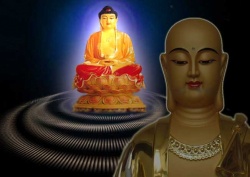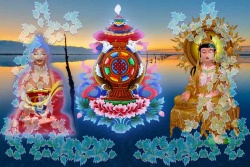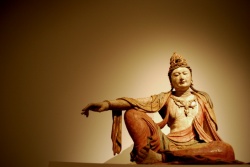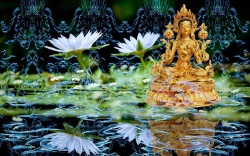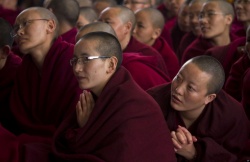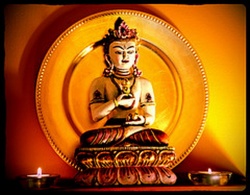Shinto & Buddhism
Most Japanese people observe rites of the native Shinto religion and those of Buddhism, and even some of Christianity; a person may celebrate a local festival at a Shinto shrine, a wedding at a Christian church or chapel, and a funeral at a Buddhist temple.
Many Japanese people regard the religious practices of Japan as part of the nation’s culture, rather than a matter of individual belief or faith.
The Zen form of Buddhism emphasises life experience and daily meditation, rather than theoretical knowledge or study of religious texts.The fundamental Zen practice of zazen, or seated meditation, recalls both the posture in which the Buddha is said to have achieved enlightenment, and the mindfulness and concentration which are part of the Eightfold Path as taught by the Buddha.
During zazen, positions such as the lotus, half-lotus, Burmese, or seiza postures are used. Awareness is directed towards one’s posture and breathing. Often, a cushion (zafu) placed on a padded mat (zabuton) is used to sit on; in some cases, a chair may be used. In the Rinzai school of Zen, practitioners typically sit facing the centre of the room, while Soto Zen meditation is traditionally done sitting facing a wall.
Because the Zen tradition is for direct communication rather than scriptural study, the Zen teacher has traditionally played a central role. A Zen teacher is a person ordained in any tradition of Zen to teach the dharma (right way of living, or natural harmony), to guide students of meditation, and to perform rituals.
There are certain techniques common in the Zen tradition which seem unconventional, but which are intended to shock a student out of habitual ways of thought. These include the loud belly shout known as katsu. It is common in many Zen traditions today for Zen teachers to have a stick with them during formal ceremonies – a symbol of authority which can be also used to strike on the table during a talk.
Shinto is the native religion of Japan, and was once its state religion. It involves the worship of kami, or spirits. Some kami are local – the spirit of a particular place – but others represent major natural phemonena like Amaterasu, the Sun goddess, or Mount Fuji.
The word Shinto is a combination of two kanji (Chinese characters): “shin”, meaning gods or spirits, and “tō” meaning a way or path (like Tao or dao in Chinese). So Shinto is often translated as “The Way of the Gods”.
Shinto can be seen as a form of animism. The afterlife, and belief, are not major concerns in Shinto; the emphasis is on fitting into this world instead of preparing for the next, and on ritual and observance rather than on faith.
The religion has no fixed dogma or book, no holiest place, no person or kami regarded as the holiest, and no defined set of prayers. Instead, Shinto is a collection of rituals and methods meant to regulate the relations between living people and the spirits.
The main theme in the Shinto religion is love and reverence for natural artifacts and processes. So a waterfall or a special rock might come to be regarded as a spirit (kami) of that place; so might abstract things like growth and fertility. Sacred objects, such as rocks or trees, can be recognized by the special ropes (shimenawa) and white paper strips attached to them.
The principal worship of kami is done at public shrines (jinja), although many people also have a small private shrine at home(kamidana) – sometimes only a high shelf with a few ritual objects.
Some public shrines are elaborate and impressive buildings, but many are small structures in typical Japanese architectural style. Shrines are commonly fronted by a distinctive gate (torii). These gates form a symbolic barrier separating the living and the spirit-worlds. There are often two guardian animals at each side of the gate, protecting the entrance.
To pay respects at a Shinto shrine, stand in front of the cashbox and the long ropes dangling from a gong. The shrine may contain offerings of food and sake placed before a symbol of the kami – typically, white paper gohei (hanging zigzags) or a mirror. Most people toss a coin in the box, sound the gong a couple of times, bow deeply twice, clap hands firmly twice, bow once deeply, once lightly and then back away politely to avoid turning their back to the shrine.
Shinto beliefs and ways of thinking influence Japanese society, even today. Many famously Japanese practices have origins either directly or indirectly rooted in Shinto.
For example, the Shinto ideal of harmony with nature underlies such typically Japanese arts as flower-arranging (ikebana), traditional architecture, and garden design.
Obvious links to Shinto can be seen in sumo wrestling, where many Shinto-inspired ceremonies must be performed before a bout, such as purifying the wrestling arena by sprinkling it with salt. Many Japanese customs, such as using wooden chopsticks, and removing shoes before entering a building, have their origin in Shinto beliefs and practices.
Buddhism came to Japan from China in the 6th century, bringing many other aspects of the highly-developed culture of the Asian mainland with it. The form of Buddhism established in Japan through China is the Mahayana (Great Vehicle), rather than the Theravada Buddhism of India, Sri Lanka, and other southern Asian nations.
When the shoguns took power in the 1100s, and the administrative capital moved to Kamakura, new forms of Buddhism arrived. The most popular was Zen (see below), known in China as Chan and in Korea as Seon.
Another form of Buddhism arrived in the Kamakura period, known as Jodo-kyo or “Pure Land” Buddhism. Pure Land Buddhism emphasizes the role of Amida Buddha or the Buddha of the Western Paradise. According to this school, if the phrase “Namo Amida Butsu” is recited, upon death a person will be taken by Amida to the “Western Paradise” or “Pure Land” and from then on to Nirvana.
A more radical form of Buddhism was Nichiren Buddhism, created by the monk Nichiren, which praised the Lotus Sutra. Nichiren Buddhism is the second largest form, and includes Soka Gakkai, a very radical Nichiren denomination, whose political wing forms the conservative Buddhist New Komeito Party, Japan’s third largest political party.
In Japan’s history, Shinto and Buddhism were closely knit, and religious practices developed where forms of Shinto and Buddhism were merged together. In 1868, after the Meiji Restoration, Buddhism and Shintoism were separated, but many Japanese still adhered to both.
Today, most Japanese people observe both Buddhism and Shinto, according to the occasion, without any conflict or contradition between the two.
While weddings are often Shinto or Christian ceremonies, funerals (soshiki) are almost always Buddhist. The body is cleaned, dressed in white robes and laid with the head facing north. There is a wake, where mourners present a gift of money (koden).
At the funeral the next day, mourners gather at a photograph of the deceased and a priest from the local temple recites sutras. Most deceased are cremated and pieces of their bones placed in a small jar which is placed on the butsudan altar in the home until it is buried. Relatives often pray for the deceased at the butsudan, and visit the grave during the Bon festival.
Source
http://www.japanspecialist.co.uk/travel-tips/shinto-buddhism/
